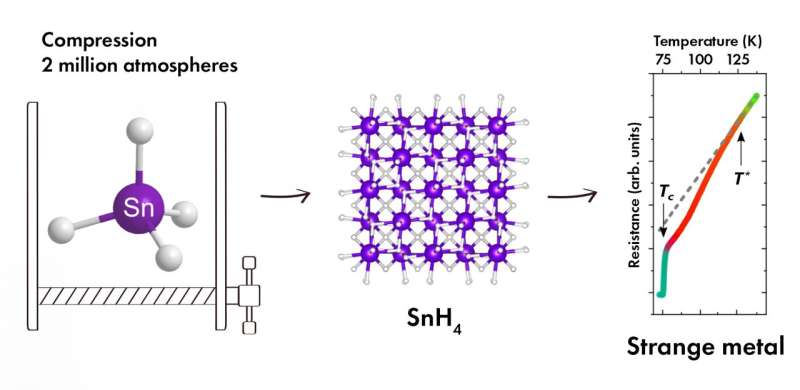This article has been reviewed according to Science X's editorial process and policies. Editors have highlighted the following attributes while ensuring the content's credibility:
fact-checked
peer-reviewed publication
trusted source
proofread
Researchers discover tin hydride with properties of strange metal

Scientists from Skoltech, the Shubnikov Institute of Crystallography, and the Center for High Pressure Science and Technology Advanced Research (HPSTAR) in Beijing, China, are exploring the superconductivity of polyhydrides—compounds of metals and hydrogen formed at high pressure. These compounds are expected to function at higher temperatures than cuprate superconductors.
Together with colleagues from other leading research institutes in Russia, China, Germany, and the U.S., the team has recently published an article in Advanced Science, where they introduce previously unknown tin hydrides.
Superconductivity refers to conducting electricity without any losses or resistance. Superconductors greatly simplify transmission of electricity and are used in technological advances—for example, in large magnets and quantum computers that are million times faster in solving tasks beyond the capacity of a normal computer. Now, though, this technology is highly expensive because superconductors function only at very low temperatures—mostly, below -196°C.
"After new materials with near-record critical temperatures, such as H3S or LaH10, were discovered, high-temperature hydride superconductivity started to gain interest. In this context, it is important to understand and analyze physical mechanisms of conductivity and superconductivity in hydrides, as well as the structure of new materials, otherwise we can obtain inaccurate data. Our studies successfully address this issue," states study co-author, Assistant Professor from the Project Center for Energy Transition Alexander Kvashnin.
The research team from Skoltech and the Center for High Pressure Science and Technology Advanced Research (HPSTAR) in Beijing performs experiments to move toward achieving room-temperature superconductivity. "Previously, we studied superconducting polyhydrides of thorium, yttrium, cerium, lanthanum-yttrium, and lanthanum-cerium at the pressure of up to 2 million atmospheres. The maximum temperature that we managed to achieve was around 253 degrees Kelvin (approximately -20°C)," says a study co-author and Skoltech graduate, a postdoctoral fellow at the Center for High Pressure Science and Technology Advanced Research (HPSTAR) in Beijing Dmitrii Semenok.
In the new paper, researchers studied the chemical interaction between tin (Sn) and hydrogen (H2) under the pressure of 1.8–2.4 million atmospheres through electric transport measurements and synchrotron X-ray single crystal and powder diffraction.
"For the experiments, we use high-pressure diamond anvil cells with two diamond anvils that forcefully press to each other. We put a small sample of the studied material between them—in this case, the material was liquid stannane, a molecular tin hydride SnH4. When diamonds are pressed, an area of 50 micrometers experiences quite a high pressure—up to 2–2.5 million atmospheres.
"As a result, properties of the substance change and new compounds of tin and hydrogen appear. The transparent liquid SnH4 turns into a semiconductor, then metal, and later superconductor with the critical temperature of 72 Kelvins. Electrical transport properties were analyzed with metallic leads sputtered on the diamond anvils and by passing an electrical current through the sample. We studied the structure of new tin hydrides using single crystal and powder X-ray diffraction," describes Semenok.
As researchers argue, SnH4 under pressure exhibits unusual properties—electrical resistance and magnetoresistance of this hydride in the non-superconducting state are almost linearly dependent on the temperature and applied magnetic field accordingly. The upper critical magnetic field is also linearly dependent on the temperature down to 2 K deviating from the common models. The behavior of the tin tetrahydride is very similar to that of cuprate superconductors, which are widely referred to as "strange," non-Fermi-liquid metals.
"Strange" metals conduct electricity differently as compared to usual metals. Scattering of electrons in them and their electrical resistance are affected not only by thermal vibrations of the lattice and electron-electron interaction but also by other factors and exotic particles, such as superconducting fluctuations, magnons, spin and charge density waves.
"Thus, our work serves as a bridge between cuprate superconductivity, rich in quantum effects, and hydride superconductivity at high pressures. Other superconducting hydrides with great practical potential (for example, a lanthanum superhydride LaH10) can also be 'strange' metals. More thorough research is still needed," says Semenok.
Researchers are planning to keep studying physical properties of superconducting polyhydrides with an emphasis on quantum effects in them at low temperatures. The team is particularly interested in cerium hydrides CeH9 и CeH10. Their large samples can be obtained at much lower pressure—nearly 1 million atmospheres.
More information: Ivan A. Troyan et al, Non‐Fermi‐Liquid Behavior of Superconducting SnH4, Advanced Science (2023). DOI: 10.1002/advs.202303622
Journal information: Advanced Science
Provided by Skolkovo Institute of Science and Technology





















